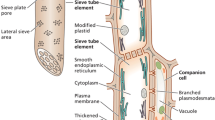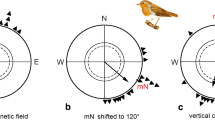Abstract
Semi-circadian rhythms of spontaneous photon emission from wheat seedlings germinated and grown in a constant environment (darkened chamber) were found to be synchronized with the rhythm of the local gravimetric (lunisolar) tidal acceleration. Time courses of the photon-count curves were also found to match the growth velocity profile of the seedlings. Pair-wise analyses of the data—growth, photon count, and tidal—by local tracking correlation always revealed significant coefficients (P > 0.7) for more than 80% of any of the time periods considered. Using fast Fourier transform, the photon-count data revealed periodic components similar to those of the gravimetric tide. Time courses of biophoton emissions would appear to be an additional, useful, and innovative tool in both chronobiological and biophysical studies.





Similar content being viewed by others
References
Barlow PW, Fisahn J (2012) Lunisolar tidal force and the growth of plant roots, and some other of its effects on plant movements. Ann Bot. doi:10.1093/aob/mcs038
Barlow PW, Klingelé E, Klein G, Mikulecký M (2008) Leaf movements of bean plants and lunar gravity. Plant Signal Behav 3:1083–1090
Barlow PW, Mikulecký M, Střeštík J (2010) Tree-stem diameter fluctuates with the lunar tides and perhaps with geomagnetic activity. Protoplasma 247(1-2):25–43. doi:10.1007/s00709-010-0136-6
Birtic S, Ksas B, Genty B, Mueller MJ, Triantaphylidès C, Havaux M (2011) Using spontaneous photon emission to image lipid oxidation patterns in plant tissues. Plant J 67:1103–1115. doi:10.1111/j.1365-313X.2011.04646.x
Brown FA Jr, Chow CS (1973) Lunar-correlated variations in water uptake by bean seeds. Biol Bull 145:265–278
Chao B (1998) A study on ultra-weak photon-counting imaging of rice seeds at the stage of germination. Acta Biophys Sin 14(4):772–776
Chen W, Xing D, Wang J, He Y (2003) Rapid determination of rice seed vigour by spontaneous chemiluminescence and singlet oxygen generation during early imbibition. Luminescence 18:19–24. doi:10.1002/bio.695
Colli L, Facchini U (1954) Light emission by germinating plants. Nuovo Cimento 12:150–153
Colli L, Facchini U, Guidotti G, Dugnani Lonati R, Orsenigo M, Sommariva O (1955) Further measurements on the bioluminescence of the seedlings. Cell Mol Life Sci 11:479–481
Fontes CMGA, Gilbert HJ (2010) Cellulosomes: highly efficient nanomachines designed to deconstruct plant cell wall complex carbohydrates. Annu Rev Biochem 79:655–681. doi:10.1146/annurev-biochem-091208-085603
Gallep CM, Conforti E (2005) Low-cost, simplified systems for photon-counting measurements in biological samples. SBMO/IEEE MTT-S Intern Microw Optoel Conf 1:188–191. doi:10.1109/IMOC.2005.1580049
Gallep CM, dos Santos SR (2007) Photon-counts during germination of wheat (Triticum aestivum) in wastewater sediment solutions correlated with seedling growth. Seed Sci Technol 35:607–614
Inagaki H, Imaizumi T, Wang G-X, Tominaga T, Kato K, Iyozumi H, Nukui H (2009) Sulfonylurea-resistant biotypes of Monochoria vaginalis generate higher ultraweak photon emissions than the susceptible ones. Pestic Biochem Physiol 95:117–120. doi:10.1016/j.pestbp.2009.08.002
Klein G (2007) Farewell to the internal clock: a contribution in the field of chronobiology. Springer, New York
Kobayashi M, Inaba H (2000) Photon statistics and correlation analyses of ultraweak light originating from living organisms for extraction of biological information. Appl Opt 32:183–192. doi:10.1364/AO.39.000183
Kolisko E, Kolisko L (1939) Agriculture of tomorrow. Kolisko Archive Publications, Stroud
Kollerstrom N, Staudenmaier G (2001) Evidence for lunar–sideral rhythms in crop yield: a review. Biol Agric Hortic 19:247–259
Longman IM (1959) Formulas for computing the tidal acceleration due to the moon and the sun. J Geophys Res 64:2351–2355
Papadimitriou S, Sun J, Yu PS (2006) Local correlation tracking in time series. Intern Conf Data Min. doi:10.1109/ICDM.2006.99
Rahnama M, Tuszynski JA, Bókkon I, Cifra M, Sardar P, Salari V (2011) Emission of mitochondrial biophotons and their effect on electrical activity of membrane via microtubules. J Integr Neurosci 10:65–88
Rastogi A, Pospíšil P (2011) Spontaneous ultraweak photon emission imaging of oxidative metabolic processes in human skin: effect of molecular oxygen and antioxidant defense system. J Biomed Opt. doi:10.1117/1.3616135
Slawinska D, Polewski K (1992) The stress-induced electromagnetic emission from biosystems: chemiluminescence response of plants to mechanical and chemical damage. Bioelectrochem Bioenerg 28:483–488. doi:10.1007/BF01947992
Spruyt E, Verbelen J-P, de Greef JA (1987) Expression of circaseptan and circannual rhythmicity in the imbibition of dry stored bean seeds. Plant Physiol 84:707–710
Takeda M, Kobayashi M, Takayama M, Suzuki S, Ishida T, Ohnuki K, Moriya T, Ohuchi N (2004) Biophoton detection as a novel technique for cancer imaging. Cancer Sci 95:656–661. doi:10.1111/j.1349-7006.2004.tb03325.x
Yan Y (2005) Biophoton emission and delayed luminescence of plants. In: Shen X, van Wijk R (eds) Biophotonics. Kluwer, Amsterdam, pp 195–204
Yoshinaga N, Kato K, Kageyama C, Fujisaki K, Nishida R, Mori N (2006) Ultraweak photon emission from herbivory-injured maize plants. Naturwissenschaften 93:38–41. doi:10.1007/s00114-005-0059-9
Zürcher E (2001) Lunar rhythms in forestry traditions—lunar-correlated phenomena in tree biology and wood properties. Earth Moon Planets 85–86:463–478. doi:10.1023/A:1017018821490
Zürcher E, Cantiani MG, Sorbetti-Guerri F, Michel D (1998) Tree stem diameters fluctuate with tide. Nature 392:665–666. doi:10.1038/33570
Zürcher E, Schlaepfer R, Conedera M (2010) Looking for differences in wood properties as a function of the felling date: lunar phase-correlated variations in the drying behavior of Norway Spruce (Picea abies Karst.) and Sweet Chestnut (Castanea sativa Mill.). Trees 24:31–41. doi:10.1007/s00468-009-0376-2
Acknowledgments
Authors are grateful to FAPESP (Fundação de Amparo `a Pesquisa do Estado de São Paulo, Brazil) and CNPq (Conselho Nacional de Pesquisa, Brazil) for partial support. C. M. Gallep is particularly thankful to Prof. E. Conforti (FEEC/Unicamp) for his previous support to LaFA group, and to Peter Bieckark (Sítio das Fontes) for his inspiring thoughts, deeds and discussions.
Author information
Authors and Affiliations
Corresponding author
Additional information
Communicated by: Sven Thatje
Rights and permissions
About this article
Cite this article
Moraes, T.A., Barlow, P.W., Klingelé, E. et al. Spontaneous ultra-weak light emissions from wheat seedlings are rhythmic and synchronized with the time profile of the local gravimetric tide. Naturwissenschaften 99, 465–472 (2012). https://doi.org/10.1007/s00114-012-0921-5
Received:
Revised:
Accepted:
Published:
Issue Date:
DOI: https://doi.org/10.1007/s00114-012-0921-5




